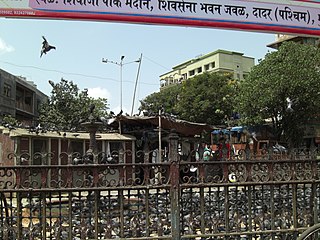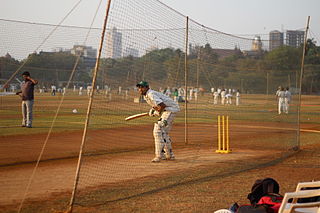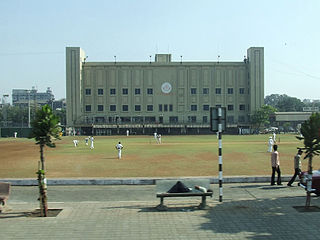
Dadar ([d̪aːd̪əɾ]) is a densely populated residential and shopping neighbourhood in Mumbai. It is also a prominent railway and bus service hub with local and national connectivity. It is Mumbai’s first planned area and it's a hub for the city's Marathi culture.
Matunga is a Suburb in Mumbai, India. It is accessible from the Matunga Road station on the Western line, Matunga station on the Central Line and King's Circle station on the Harbour Line.

Marine Drive is a 3 kilometre-long promenade along the Netaji Subhash Chandra Bose Road in Mumbai, India. The road and promenade were constructed by Pallonji Mistry. It is a banana-shaped, six-lane concrete road along the coast of a natural bay. At the northern end of Marine Drive is Girgaon Chowpatty and the adjacent road links Nariman Point at the southern tip to Babulnath and Malabar Hill at the northern tip. Marine Drive is situated on reclaimed land facing west-south-west. Marine Drive is also known as the Queen's Necklace because, when viewed at night from an elevated point anywhere along the drive, the streetlights resemble a string of pearls in a necklace.

The Mumbai cricket team, formerly known as the Bombay Cricket Team, is a cricket team which represents Mumbai in Indian domestic cricket. It is governed by Mumbai Cricket Association. Its home ground is Wankhede Stadium in Churchgate.

The Brabourne Stadium is an international cricket stadium in Mumbai in Western India, built in the British Bombay era. It is the home ground of the Mumbai men's and women's cricket teams. It can accommodate 50,000 people for sports matches. The ground is owned by the Cricket Club of India (CCI). The North Stand of the Brabourne had housed the Board of Control for Cricket in India (BCCI) headquarters and the 1983 Cricket World Cup trophy until 2006, when both were moved to the newly built Cricket Centre at the nearby Wankhede Stadium.

The Bombay Gymkhana, established in 1875, is a premier private members' club in the city of Mumbai, India.

George Frederick Vernon was an English cricketer who played first-class cricket for Middlesex County Cricket Club. He also played one Test match for England during the first-ever Ashes tour in 1882-83.

Khershedji Rustomji Meherhomji was an Indian cricketer who played as a wicket-keeper. Meherhomji toured England in 1936 and played in the Test at Manchester. He represented Parsis in Bombay Pentangular and various sides in the Ranji Trophy. His uncle Rustomji Meherhomji toured England with the 1911 All India team.
The Bombay Tournament was an annual cricket competition held in British India between 1892 and 1946. Until 1936, matches were played on either the Gymkhana Ground in Bombay or the Deccan Gymkhana Ground in Poona, and then at the Brabourne Stadium in Bombay until the tournament was terminated in 1946. The tournament was known variously as the Bombay Presidency Match, Bombay Triangular, Bombay Quadrangular, and Bombay Pentangular, depending on the number of competing teams.

Azad Maidan is a triangular-shaped maidan in the city of Mumbai, India. It is located on 25 acres (10 ha) of land near the Chhatrapati Shivaji Terminus station. It is a regular venue for inter-school cricket matches. The name Azad means "liberty" in Persian. The ground is known for its cricket pitches, for protest meetings, and for political rallies. The Bombay Gymkhana clubhouse was built in 1875, at the southern end of the maidan.
The Mumbai Cricket Association is the governing body for cricket in Mumbai and surrounding regions such as Thane district, Palghar district and Navi Mumbai. Its headquarters are situated at Cricket Centre in Churchgate.

In the 1889–90 cricket season, an English team managed by George Vernon and captained by Lord Hawke toured Ceylon and India. It was a pioneering tour being the first visit by an English team to India and the second to Ceylon, following the stopover by Ivo Bligh's team to Australia in 1882–83. Vernon's team, known as G. F. Vernon's XI, was entirely composed of players with amateur status and, in the absence of professionals, none of its matches have been recognised as first-class. In all, they played thirteen matches from 28 November 1889 to 1 March 1890, starting with two games in Ceylon before moving on to Calcutta where the Indian part of the tour began in late December.
The Parsiscricket team was an Indian first-class cricket team which took part in the annual Bombay tournament. The team was founded by members of the Zoroastrian community in Bombay. It is affiliated to Mumbai Cricket Association.

The Karachi Gymkhana (KG) is a premier gymkhana in the city of Karachi. It is located on Club Road in Karachi, Sindh, Pakistan, opposite to the Commissioner House.
Gymkhana Ground may refer to:

Duke and Sons Pvt. Ltd was an Indian manufacturing company based in Bombay. Established in 1889, Duke produced and marketed soft drinks. It was originally owned by the Pandole family, a well-known Parsi business name. In 1994, the company was acquired by Pepsi, which relaunched the Duke's brand in 2011 through its Indian subsidiary.

Parmananddas Jivandas Hindu Gymkhana, Primarily, historically known as Hindu Gymkhana is a gymkhana located along Marine Drive in Mumbai. It originally started as Hindu Cricket Club in 1878. The gymkhana itself was inaugurated by then Governor of Bombay, Lord Harris on 5 May 1894. At that time it was located on Marine Lines, which was its only access route as Marine Drive was yet to be reclaimed. Until 1942, membership of the gymkhana was restricted to people of Hindu religion. In 1942, when the government occupied the adjacent premises of the Islam Gymkhana and Parsi Gymkhana in Bombay during World War II, the gymkhana threw its membership open to Parsis and Muslims as an "emergency measure". Hindu Gymkhana was responsible for fielding the Hindu XI in the Bombay Quadrangular and its successor Bombay Pentangular cricket tournaments. The gymkhana is one of the founder members of the Bombay Cricket Association. Hindu Gymkhana organises several tournaments such as Purshottam Shield Cricket Tournament, which is the oldest tournament started in 1912 that it organises.

Islam Gymkhana, is a gymkhana located along Marine Drive in Mumbai. Land for the gymkhana was allotted by the then Governor of Bombay, Lord Harris in 1890.
Parsi Gymkhana Ground is a multipurpose club ground in Mumbai, Maharashtra. The ground is mainly used for organizing matches of football, cricket and other sports.
PJ Hindu Gymkhana Ground is a multi purpose club ground in Marine Drive, Mumbai, Maharashtra. The ground is mainly used for organizing matches of football, cricket and other sports.












